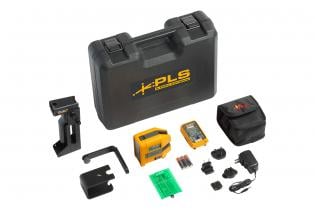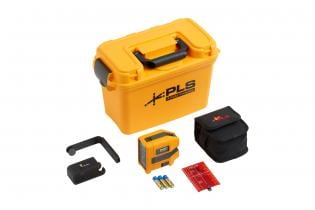Laser levels – Self-level laser, rotary laser level, laser transit
Fluke laser levels streamline your work with bright references and accuracy to 6mm at 30 meters: self-level lasers, rotary laser levels, laser transit levels, and more.
Experience the pinnacle of precision with our comprehensive range of self-level laser tools. Designed for professionals who demand accuracy and efficiency, Fluke laser levels deliver sharp, high-visibility laser lines and precise reference points, improving efficiency and accuracy in every task. Our rugged tools are perfect for both the construction site or a home renovation project.
Choose from our range of self-level laser levels for seamless alignment or rotary laser levels for extensive leveling tasks. A rotary laser level is a leveling tool that fires a beam of light and rotates 360 degrees on a horizontal or vertical plane, providing a vital reference point for measuring and working on large areas. Rotary laser levels offer a seamless level line around a work site, saving time and enhancing the accuracy of work on big projects. We also offer laser transit levels, high-precision devices used for transferring points from floor to ceiling or around the room. A transit laser level contains a built-in spirit level mounted on a tripod, helpful in measuring the position of objects and lines, and ideal for reference line, surveying, and building applications.
Fluke provides tools from industry leader Pacific Laser Systems (PLS). The PLS 6G RBP point-and-cross line green laser level kit, with its precision and laser transit functionality, showcase the brand’s robustness and accuracy. PLS lasers utilize a self-leveling, swift-settling, pendulum that ensures precise point and reference lines in nearly an instant. Choose from vertical or horizontal modes and seamlessly integrate lines and points. The pendulum lock adds an extra layer of security during transportation or accidental drops. Fluke PLS lasers are ideal for plumbing, leveling, and squaring, general layout, square alignment, finish carpentry, and tasks such as metal or wood stud installation.

PLS 6G RBP Point and Cross Line Green Laser Level Kit
Green laser level kit with rechargeable battery pack features 30 hours of operating time.
PLS 6R RBP Point and Cross Line Laser Level Kit
Red combination point and cross line laser level with rechargeable battery.
PLS 180G RBP Green Cross Line Laser Level Kit
Kit includes battery pack, reflective target, floor stand, L-bracket, carrying case and wall...
PLS 180R RBP Cross Line Laser Level Kit
Self-leveling laser level includes rechargeable battery pack.
PLS 3x360G Three-plane Laser Level
Combining all of the finest qualities of your favorite PLS gear, now with best-in-class accuracy and...
PLS 3x360R Three-plane Laser Level
Combining all of the finest qualities of your favorite PLS gear, now with best-in-class accuracy and...
PLS 3R KIT, 3-Point Red Laser Kit
This professional self-leveling three-point red laser level allows for fast, accurate layout of...
PLS 3G KIT, 3-Point Green Laser Kit
This professional self-leveling three-point green laser level allows for fast, accurate layout of...
PLS 5R KIT, 5-Point Red Laser Kit
The new PLS 5R red laser levels offer the durability and precision you expect from PLS, a Fluke...
PLS 5G Laser Level
The new PLS 5G green laser levels offer the durability and precision you expect from PLS, a Fluke...
PLS H2 Rotary Laser Level
The H2 is a horizontal only rotary laser. The H2 is easy-to-use and fully self-leveling, designed...
PLS HV2R KIT, Manual Slope Red Rotary Laser Kit
The PLS HV2R red beam rotary lasers are designed for the construction job site, offering a rugged...
PLS HV2G SYS, Manual Slope Green Rotary Laser System
The PLS HV2G green beam rotary lasers are designed for the construction job site, offering a rugged...
What is a Laser Level?
A laser level is a control tool used in the test and measurement industry. This highly precise instrument projects a fixed red or green beam of light to create a straight and level reference point. The laser level is frequently employed in construction, surveying, and other industrial fields where accurate alignment is crucial.
What is a Self-Level Laser Level?
A self-level laser is an advanced version of the standard laser level. This tool automatically adjusts itself to create a level line within a certain range. Even when placed on a slightly uneven surface, the self-level laser will self-correct to ensure that the projected beam is perfectly level. This feature greatly enhances the tool's accuracy and reliability, making it a preferred choice in many industrial environments.
Self-level lasers are critical for many building, plumbing, and general levelling tasks where the ability to automatically find and maintain a level within a set range is advantageous. A manual laser level necessitates the user level the unit themselves by adjusting the thumb screws or consulting bubble vials.
How do self-leveling lasers work? Originally, they self-leveled thanks to pendulum plumb bobs, with a floating platform leveled by wire suspended compensators. More commonly, a pendulum or gimbal technique is used: the pendulum free-floats, using gravity and the help of magnets. Electronic self-level laser tools employ pendulums, but instead of floating, the pendulum has an electronic sensor that directs the pendulum’s movement.
What Does a Laser Level Do?
A laser level serves a multitude of functions in the test and measurement industry. Its primary function is to provide a straight, level line for aligning objects or marking out positions. This is especially useful in construction tasks such as laying out floor tiles, hanging pictures, or installing cabinets. The rotary laser level, another type of laser level, can project a 360-degree horizontal or vertical beam, making it perfect for layout and leveling applications across larger areas.
How to Use a Laser Level?
Using a laser level begins with setting up the tool on a stable surface or tripod. For self-leveling laser levels, allow a few seconds for the tool to auto-adjust. Once the laser level is stable, it will project a level beam onto the desired surface. You can then use this reference line to complete your task with precision and accuracy.
- Place the level laser on your surface and level it using the manual bubble-level method.
- Turn on the laser. Mark the surface and reposition to verify your marks before working. Using a self-leveling tool? Just mark and double-check your measurement.
- Choose a location to measure from – preferably stable, dry, and safe.
- Verify the stability of your setup.
How to Choose the Right Laser Level?
When selecting a laser level, consider your specific needs. If you require a tool for simple tasks such as hanging pictures, a basic laser level will suffice. However, for larger projects like installing cabinets or working on construction sites, a self-leveling laser level or rotary laser level might be more suitable. Always consider factors such as range, accuracy, and battery life when choosing the right laser level for your needs.
What is a Rotary Laser Level?
A rotary laser level emits a rotating beam of light that creates a horizontal or vertical line over a significant distance. This type of laser level is ideal for outdoor projects such as landscaping, construction, and site grading. For long distances or work in broad daylight, a laser receiver or detector can help to verify measurement. Rotary laser levels generally provide horizontal self-leveling capabilities, finding a true level line by themselves. Some rotary levels also offer grading – the ability to measure and provide a reference for grades, ideal for water drainage uses.
What is a Laser Transit Level?
A laser transit level is a hybrid between a telescope and a laser level that commonly sits on a tripod. Laser transits provide a highly accurate level line and can also measure angles. This type of laser level is typically used in construction and surveying where precise measurements are required. Located on top of the tool, the telescope moves 360° degrees on a horizonal plane and 45° in each direction. Transit levels differ from traditional builder’s levels due to the critical functionality of moving vertically – allowing users to measure object positions and angles with ease, compared to a horizontally-locked in builder’s level.
How are Rotary and Transit Laser Levels Used?
Both rotary and transit laser levels are used in a variety of ways. Rotary laser levels are commonly used in large outdoor projects where a 360-degree level line is needed. On the other hand, transit laser levels are used for tasks that require precise angle measurements, such as building a staircase or setting a grade for drainage. Both types are invaluable tools in the construction and surveying industries.












